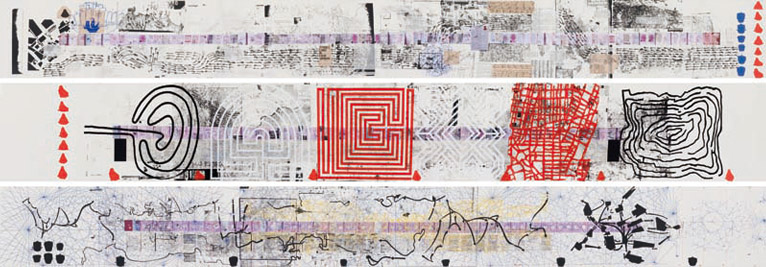DO A BOOK
| June 6, 2012 | Post In LEAP 14

For thousands of years, the book has been a vehicle for the unbounded exploration of objective knowledge and experience and subjective feeling and imagination. Often books convey truths or tenets that, although they cannot be proven, come to the author in a flash of insight. Seen this way, the concept of an “artist’s book” might very well endow the “book” with an air of lively revolt, which springs primarily from the artists’ roaring creativity. Subordinately, it emerges from the strengths of the medium’s shape and materials: among other factors, the freedom of form books permit (whether text, illustration, or collage), the sheer quantity of information they can hold, the convenience with which they are carried and transported, and the fact that they are easier to acquire and appreciate than costly works of art, whose expense relegates them to galleries and art museums. Thus the 24 works by international artists in White Space Beijing’s “Do A Book” revel in the flexibility and diversity of the show’s theme.
The most frequently seen type of “artist’s book” is also the most personal. These are books that proceed from the artist’s experience, emotions, or interests. They use text (either the artist’s own, or quotations) and, oftentimes, hand-drawn designs to create books that feel truly readable. Guo Hongwei’s Tree is a painted imitation of Parkett, while Lukas Birk’s Rebirth Reverie uses a collage of paintings to record the story of his journey around the world (beginning in China). The effect is not unlike the interweaving of words spoken in one’s sleep. Post Testament, an early Xu Bing work, reexamines and deconstructs the properties of texts from an ontological perspective. Text from an old edition of the King James New Testament is intermixed with American pulp fiction, treading on the blurry boundary between the classic and the vulgar, and probing the ways that visual structures interfere with modes of reading.
From William Blake to the pamphlets of the post-WWI Dadaists, Suprematists, and Futurists and on to the works of post-WWII Conceptualists and Minimalists (such as Sol LeWitt’s classic Grids), artists’ books have given artists a miniature stage to express their ideas. In the spirit of past pairings (see the illustrations of Matisse and the poems of Stéphane Mallarmé for an example), “Do A Book” features a collaboration between the artist Terry Winters and the writer Ben Marcus. Meanwhile, American artist Kiki Smith’s foldout engraving Companion uses Little Red Riding Hood as a prototype for reimagining the relationship between humans and wolves, and Sarah Sze’s Notepad, although in book form, seems more like a paper sculpture.
The space’s two narrow walls are stuffed with individual works, as if to affirm that works on paper can also transmit information in quantities typically seen only in books. Rirkrit Tiravanija’s “alternative autobiography” traces 20 years’ worth of the artist’s passports and visas, supplemented by entries from his diary and numerous other hard-to-decipher details, like topographic maps. Rutherford Chang’s work, meanwhile, is a one-time statistical survey: the artist cut out the portraits accompanying The Wall Street Journal stories for the entire year of 2008. Although it might seem like nothing more than a plain statement of reality, observers can, through viewing the frequency with which faces appear, learn more about that year’s unusual configurations of political and economic power.
Perhaps amidst contemporary art’s leaning towards the big and spectacular, artists’ books are a practice worth encouraging, if only for their direct expression of painstaking labors, of delicate feelings delicately stated, and of careful, deliberate thought. Alas, for such a themed exhibition, held as it is in China, the lack of a single artist’s book that truly looks at China from the perspective of contemporary art feels— especially given China’s long tradition of painting and calligraphy— like an opportunity wasted. Chang Xuyang (Translated by Matthew Schrader)


